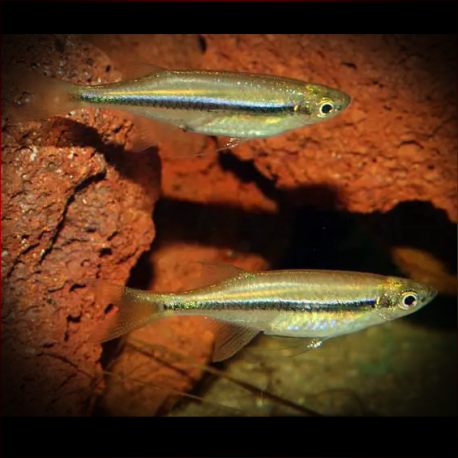More info
Datasheet
| Minimum Tank Size | 160 litres / 42.27 US gallons |
| Maximum Size | 5.0cm / 1.97inches |
| Temperature | 20°C / 68.00°F - 26°C / 78.80°F |
| Hardness | 2.02dgH / 36ppm - 10.03dgH / 179ppm |
| pH | 6.5-7.5 |
General Description
The Malabar Hatchet Chela (Laubuka fasciata) is a species of fish classified under the Cyprinidae family. Native to the state of Kerala in southwestern India, this species is characterized by a dark longitudinal stripe running from its eye to the caudal peduncle and scattered tubercles on its lower jaw. With a maximum size of 5.0 cm, it is occasionally found in the aquarium trade and typically distinguishes itself from other Laubuka species by having 14½-16½ branched anal-fin rays and elongated pelvic fins.
Aquarium Setup
For optimal well-being, a tank size of a minimum of 160 liters is recommended for the Malabar Hatchet Chela. The preferred tank setup should mirror a flowing river or stream environment, featuring a substrate of rocks, gravel, and water-worn boulders. Additionally, driftwood branches can be added, and hardy plant species like Microsorum, Bolbitis, or Anubias spp. can survive in such conditions. Clean water is vital, given the fish's intolerance to organic waste buildup. Due to their jumping ability, a secure lid is essential in the aquarium.
Behaviour
Known for its non-aggressive nature, the Malabar Hatchet Chela can coexist with various fish species like cyprinids, loaches, cichlids, catfish, and characins. It tends to be a schooling fish, thriving best in groups of 8-10 specimens. Maintaining the fish in adequate numbers not only reduces their stress levels but also enhances the natural aesthetic of their display.
Feeding and Diet
In its natural habitat, this species feeds on both terrestrial and aquatic invertebrates as a surface feeder. In an aquarium, it readily accepts appropriately sized dried foods but should also be given live or frozen treats like Daphnia, Artemia, and chironomid larvae (bloodworm) regularly to ensure proper nutrition.
Reproduction & Dimorphism
Details on the reproduction of the Malabar Hatchet Chela remain unreported. Sexual dimorphism is observable in adult specimens, with females typically being deeper-bodied and slightly larger than males.
Habitat and Distribution
The Malabar Hatchet Chela primarily resides in the middle to lower sections of rivers and streams in Kerala, India. It favors shallow, slow-moving marginal areas with rocky or gravelly substrates. The species has been recorded in various river systems in the region, with its type locality being the Annamalai River in Chittur Taluk, Malabar, Kerala, India.

